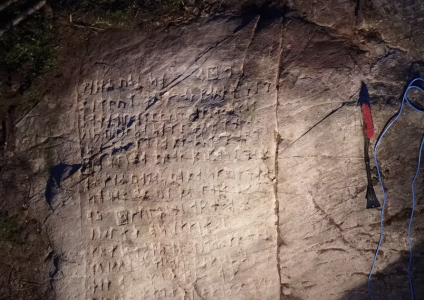Archaeologists stunned: Could this newly discovered carving in the US rewrite what we know about Jesus’ crucifixion?
- Replies 0
History, faith, and a dash of mystery—sometimes, the past has a way of surprising us in the most unexpected places.
Imagine trekking through the wilds of northern Ontario, Canada, and stumbling upon a centuries-old message carved into stone, hidden for generations beneath the roots of a fallen tree.
That’s exactly what happened near the small town of Wawa, where archaeologists have uncovered a remarkable artifact that’s turning heads in both the academic and faith communities.
A Hidden Message Revealed by Nature
The story begins in 2018, when a powerful storm toppled a tree, exposing a square-shaped inscription carved into the bedrock.
The site, remote and rugged, sits about 155 miles north of the Michigan border—a place more known for its moose than mysterious relics.
But what lay beneath the soil was no ordinary graffiti: 255 carefully etched symbols, arranged in a neat three-by-four-foot square, and an image of a boat surrounded by 16 figures.
For years, the meaning of these cryptic marks eluded experts. Enter Ryan Primrose, an archaeologist with the Ontario Center for Archaeological Education, who, with the help of Swedish runic expert Henrik Williams, finally cracked the code.

The symbols, it turns out, are Nordic runes—an ancient alphabet once used across Scandinavia. And the message? None other than the Lord’s Prayer, written in Swedish.
From the Old World to the New: The Scandinavian Connection
You might be wondering: What are Swedish runes doing in the Canadian wilderness? The answer lies in the history of the Hudson’s Bay Company (HBC), the legendary fur trading enterprise that, in the 1800s, stretched its reach from the Pacific Northwest to the Arctic.
To staff its far-flung trading posts, HBC recruited workers from across Europe, including Sweden, Norway, and Denmark. These hardy souls braved the wilds, bringing with them not just their skills, but their languages, traditions, and faith.
The carving’s boat motif, with its 16 figures, may well represent a group of Swedish workers who made the perilous journey across the Atlantic and deep into the Canadian interior.
Also read: This 160-year-old painting has an alleged time traveler–Expert decodes the mystery!
The runic inscription, intentionally buried and preserved under six inches of soil, suggests a deliberate act—perhaps a makeshift altar or a sacred space for worship in a land far from home.
The Lord’s Prayer: A Universal Thread
The Lord’s Prayer, or “Our Father,” is one of Christianity’s most enduring and beloved prayers. It appears twice in the New Testament: first in Matthew 6:9-13, during the Sermon on the Mount, and again in Luke 11:2-4, when Jesus teaches his disciples how to pray.
Its words—honoring God, seeking daily sustenance, asking for forgiveness, and guidance—have echoed through churches, homes, and hearts for nearly two millennia.
For early Christians, the Lord’s Prayer was a cornerstone of faith, recited in both communal worship and private devotion.

Over time, it became a central part of Christian liturgy across denominations—Catholic, Orthodox, and Protestant alike—and was translated into countless languages, including Swedish.
The Swedish Bible was first published in 1541, and the use of runes to transcribe the prayer may have been a way for these settlers to honor their Norse heritage while expressing their faith.
A Place of Worship in the Wilderness
What makes this discovery so compelling isn’t just the age or artistry of the carving, but what it tells us about the people who made it.
With no other artifacts found nearby, archaeologists believe the site was used as a simple, outdoor place of worship—a spiritual anchor for those living on the edge of the known world.
Also read: A Jerry Lewis Holocaust movie was shelved for decades—now the mystery might be over
Imagine the scene: a small group of Swedes, gathered around the stone, reciting the Lord’s Prayer in their native tongue, seeking comfort and connection in a vast, unfamiliar land.
Henrik Williams, the Swedish runic expert who helped decipher the inscription, put it best: “Any runic inscription is rare. Someone put all this effort into this particular text and you wonder why. The mystery does not decrease just because of its age.”
Read next: Will robots replace human sculptors? The truth behind the next art revolution

Have you ever stumbled upon a piece of history in an unexpected place? What do you think motivated these Swedish settlers to carve the Lord’s Prayer in runes, so far from home? And what does this discovery say to you about the power of faith and tradition? Share your stories, questions, and reflections in the comments below!
Imagine trekking through the wilds of northern Ontario, Canada, and stumbling upon a centuries-old message carved into stone, hidden for generations beneath the roots of a fallen tree.
That’s exactly what happened near the small town of Wawa, where archaeologists have uncovered a remarkable artifact that’s turning heads in both the academic and faith communities.
A Hidden Message Revealed by Nature
The story begins in 2018, when a powerful storm toppled a tree, exposing a square-shaped inscription carved into the bedrock.
The site, remote and rugged, sits about 155 miles north of the Michigan border—a place more known for its moose than mysterious relics.
But what lay beneath the soil was no ordinary graffiti: 255 carefully etched symbols, arranged in a neat three-by-four-foot square, and an image of a boat surrounded by 16 figures.
For years, the meaning of these cryptic marks eluded experts. Enter Ryan Primrose, an archaeologist with the Ontario Center for Archaeological Education, who, with the help of Swedish runic expert Henrik Williams, finally cracked the code.

Archaeologists in Canada have deciphered 255 Nordic runes carved into a rock, revealing the Lord’s Prayer written in Swedish, which was likely left by a Swedish worker for the Hudson’s Bay Company over 200 years ago. Image source: OCARE.
The symbols, it turns out, are Nordic runes—an ancient alphabet once used across Scandinavia. And the message? None other than the Lord’s Prayer, written in Swedish.
From the Old World to the New: The Scandinavian Connection
You might be wondering: What are Swedish runes doing in the Canadian wilderness? The answer lies in the history of the Hudson’s Bay Company (HBC), the legendary fur trading enterprise that, in the 1800s, stretched its reach from the Pacific Northwest to the Arctic.
To staff its far-flung trading posts, HBC recruited workers from across Europe, including Sweden, Norway, and Denmark. These hardy souls braved the wilds, bringing with them not just their skills, but their languages, traditions, and faith.
The carving’s boat motif, with its 16 figures, may well represent a group of Swedish workers who made the perilous journey across the Atlantic and deep into the Canadian interior.
Also read: This 160-year-old painting has an alleged time traveler–Expert decodes the mystery!
The runic inscription, intentionally buried and preserved under six inches of soil, suggests a deliberate act—perhaps a makeshift altar or a sacred space for worship in a land far from home.
The Lord’s Prayer: A Universal Thread
The Lord’s Prayer, or “Our Father,” is one of Christianity’s most enduring and beloved prayers. It appears twice in the New Testament: first in Matthew 6:9-13, during the Sermon on the Mount, and again in Luke 11:2-4, when Jesus teaches his disciples how to pray.
Its words—honoring God, seeking daily sustenance, asking for forgiveness, and guidance—have echoed through churches, homes, and hearts for nearly two millennia.
For early Christians, the Lord’s Prayer was a cornerstone of faith, recited in both communal worship and private devotion.

The inscriptions, uncovered after a fallen tree revealed the slab near Wawa, Ontario, were carefully arranged inside a square and included a drawing of a boat, possibly symbolizing the journey of the Swedish settlers. Image source: OCARE.
Over time, it became a central part of Christian liturgy across denominations—Catholic, Orthodox, and Protestant alike—and was translated into countless languages, including Swedish.
The Swedish Bible was first published in 1541, and the use of runes to transcribe the prayer may have been a way for these settlers to honor their Norse heritage while expressing their faith.
A Place of Worship in the Wilderness
What makes this discovery so compelling isn’t just the age or artistry of the carving, but what it tells us about the people who made it.
With no other artifacts found nearby, archaeologists believe the site was used as a simple, outdoor place of worship—a spiritual anchor for those living on the edge of the known world.
Also read: A Jerry Lewis Holocaust movie was shelved for decades—now the mystery might be over
Imagine the scene: a small group of Swedes, gathered around the stone, reciting the Lord’s Prayer in their native tongue, seeking comfort and connection in a vast, unfamiliar land.
Henrik Williams, the Swedish runic expert who helped decipher the inscription, put it best: “Any runic inscription is rare. Someone put all this effort into this particular text and you wonder why. The mystery does not decrease just because of its age.”
Read next: Will robots replace human sculptors? The truth behind the next art revolution
Key Takeaways
- Archaeologists in Canada have deciphered 255 Nordic runes carved into a rock, revealing the Lord’s Prayer written in Swedish, which was likely left by a Swedish worker for the Hudson’s Bay Company over 200 years ago.
- The inscriptions, uncovered after a fallen tree revealed the slab near Wawa, Ontario, were carefully arranged inside a square and included a drawing of a boat, possibly symbolizing the journey of the Swedish settlers.
- Experts believe the site served as a simple outdoor place of worship, as no other artifacts were found nearby, and the runic prayer connects Sweden’s linguistic and religious heritage with early Canadian history.
- The discovery is seen as rare and significant, highlighting not only Scandinavian migration to North America, but also how Christian practices and cultural identities were preserved by early European workers in remote Canadian regions.
Have you ever stumbled upon a piece of history in an unexpected place? What do you think motivated these Swedish settlers to carve the Lord’s Prayer in runes, so far from home? And what does this discovery say to you about the power of faith and tradition? Share your stories, questions, and reflections in the comments below!






